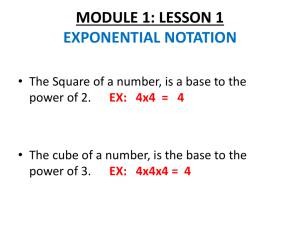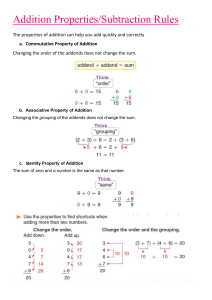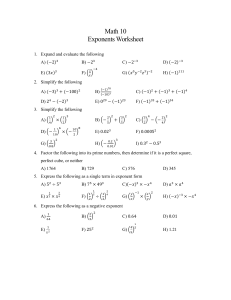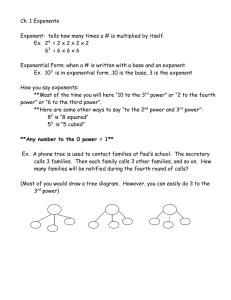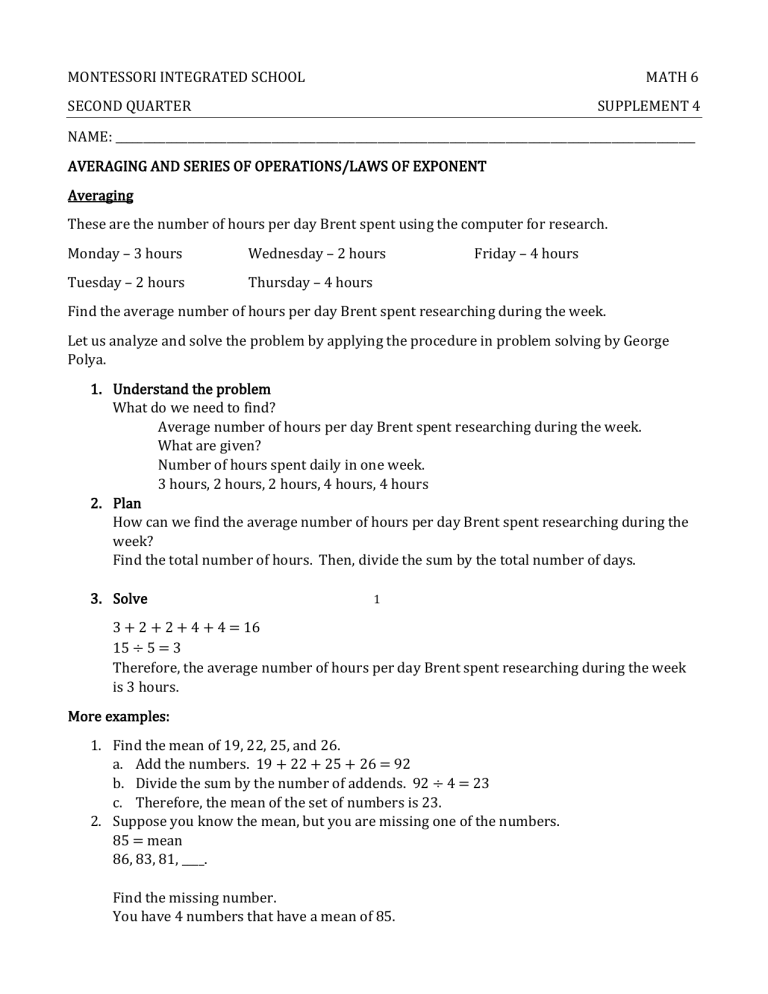
MONTESSORI INTEGRATED SCHOOL MATH 6 SECOND QUARTER SUPPLEMENT 4 NAME: ________________________________________________________________________________________________________ AVERAGING AND SERIES OF OPERATIONS/LAWS OF EXPONENT Averaging These are the number of hours per day Brent spent using the computer for research. Monday – 3 hours Wednesday – 2 hours Tuesday – 2 hours Thursday – 4 hours Friday – 4 hours Find the average number of hours per day Brent spent researching during the week. Let us analyze and solve the problem by applying the procedure in problem solving by George Polya. 1. Understand the problem What do we need to find? Average number of hours per day Brent spent researching during the week. What are given? Number of hours spent daily in one week. 3 hours, 2 hours, 2 hours, 4 hours, 4 hours 2. Plan How can we find the average number of hours per day Brent spent researching during the week? Find the total number of hours. Then, divide the sum by the total number of days. 3. Solve 1 3 + 2 + 2 + 4 + 4 = 16 15 ÷ 5 = 3 Therefore, the average number of hours per day Brent spent researching during the week is 3 hours. More examples: 1. Find the mean of 19, 22, 25, and 26. a. Add the numbers. 19 + 22 + 25 + 26 = 92 b. Divide the sum by the number of addends. 92 ÷ 4 = 23 c. Therefore, the mean of the set of numbers is 23. 2. Suppose you know the mean, but you are missing one of the numbers. 85 = mean 86, 83, 81, ____. Find the missing number. You have 4 numbers that have a mean of 85. Multiply 85 × 4 to get the total sum needed. 85 × 4 = 340 (total sum) Add the 3 numbers that you know. 86 + 83 + 81 = 250 (sum you have) Now subtract the sum you have from the total sum to find your missing number. 340 - 250 = 90 (missing number) ➢ Mean – quotient when the sum of two or more numbers is divided by the number of addends. ➢ Average – another word for mean. ➢ How to find the mean or average of numbers: 1. Add all the given numbers. 2. Divide the sum by the number of addends. ➢ How to find the missing number if the mean is given: 1. Multiply the mean by the number of addends. 2. Add the given addends. 3. Subtract the product in step 1 and the sum in step 2. Understanding Laws of Exponent Exponent tells the number of times the base is multiplied by itself. It is a shortcut of writing repeated factors in multiplication equations. Law of Exponents • Zero Exponent Any number raised to zero is equal to 1. 𝒃𝟎 = 𝟏 250 = 1 1 3740 = 1 80 0000 = 1 • Product Rule Any number raised to the nth power which is multiplied by the same number raised to the nth power is equal to the number raised to the sum of its exponents. (𝒃𝒏 )(𝒃𝒎 ) = 𝒃𝒏+𝒎 (35 )(32 ) = 35+2 = 37 (83 )(83 ) = 83+3 = 87 • Quotient Rule Any number raised to the nth power divided by the same number raised to the nth power is equal to the number raised to the difference of the exponents. 𝒃𝒏 = 𝒃𝒏−𝒎 where n > m 𝒃𝒎 23 22 • = 23−2 = 2 65 = 65−3 = 62 63 Power Rule Any number raised to the nth power and raised again to another exponent m is equal to the number raised to the product of its exponent. (𝒃𝒏 )𝒎 = 𝒃𝒏 𝒙 𝒎 (42 )3 = 42 x 3 = 46 (73 )4 = 73 x 4 = 712 Performing Series of Operations Which of these two equations is true? 4 + 2 × 3 ÷ 6 = 3 or 4 + 2 × 3 ÷ 6 = 5 How do you perform a series of operations? In performing a series of operations, we follow the GEMDAS Rule. This stands for: In the above equation, 4 + 2 × 3 ÷ 6, we perform the Multiplication first, then division and lastly addition. 4+2×3÷6=4+6÷6 =4+1 =5 Another example: 32 – 16 × 3 ÷ 8 + 14 = 32 – 48 ÷ 8 + 14 = 32 – 6 + 14 = 26 +14 = 40 Evaluate: 25 + 32 × (12 – 8) ÷ 6 = 25 + 32 × 4 ÷ 6 = 25 + 9 × 4 ÷ 6 = = 25 + 36 ÷ 6 = 25 + 6 = 31 ➢ In simplifying expressions involving series of operations, we follow the GEMDAS Rule: 1. Perform first the operations inside the grouping symbols, then simplify exponential expressions. 2. Perform multiplication/division whichever comes first from left to right. 3. Add/Subtract whichever operation comes first from left to right. A. Find the mean for each set of data. 1. 55 min, 42 min, and 1 hr 16 min Average: ________________ 2. 13 hrs, 70 min, 21 hrs, and 50 min Average: ________________ 3. 25 yrs.old, 23 yrs.old and 22 yrs.old Average: ________________ B. Evaluate the following. 4. 52 × 10 + [54 ÷ 6 – (11 × 3)] 5. 120 ÷ (5 + 1 × 2) – 5 Reference: Math in a Challenging World 5 (pp.88-89) Math in a Challenging World 6 (pp233-235; pp.239-240)
